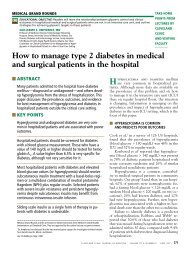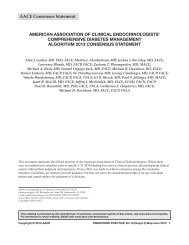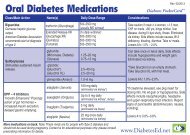Screening and Diagnostic Criteria for Diabetes 2012
Screening and Diagnostic Criteria for Diabetes 2012
Screening and Diagnostic Criteria for Diabetes 2012
You also want an ePaper? Increase the reach of your titles
YUMPU automatically turns print PDFs into web optimized ePapers that Google loves.
RECOMMENDATIONS FOR THEDIAGNOSIS AND CLASSIFICATION OF DIABETES MELLITUS <strong>2012</strong>CRITERIA FOR TESTING FOR DIABETES IN ASYMPTOMATIC ADULT INDIVIDUALS – TABLE 1DIABETESTYPEType 1Type 2RISK FACTORS <strong>and</strong> FREQUENCY OF SCREENINGType 1 prevention studies suggest that measurement of islet autoantibodies identifies individualsat risk <strong>for</strong> developing type 1 diabetes. Such testing may be appropriate in high-risk individuals,such as those with prior transient hyperglycemia or those who have relatives with type 1 diabetes,in the context of clinical research studies (http://www2.diabetestrialnet.org)1. Testing should be considered <strong>for</strong> all adults who are overweight (BMI 25) <strong>and</strong> have additionalrisk factors: History of cardiovascular disease habitual physical inactivity first degree relative with diabetes delivered baby > 9 lbs, GDM polycystic ovary syndrome HTN 140 / 90 or on meds HDL 35 mg/dl or triglyceride 250 mg/dl A1c 5.7%, IGT or IFG Other clinical conditions associated with insulin resistance (obesity, AN) high risk ethnic population (African American, Latino, Native American, Asian American,Pacific Isl<strong>and</strong>ers)2. In the absence of the above risk, start testing <strong>for</strong> diabetes at age 453. If results normal, repeat test at 3 year intervals or more frequently depending on riskSTAGETESTS TO DIAGNOSE DIABETES - TABLE 2For all the below tests, in the absence of unequivocal hyperglycemia,results should be confirmed by repeat testing.A1CNGSP certified &st<strong>and</strong>ardized assayFasting* PlasmaGlucose (FPG)*No intake 8 hrsR<strong>and</strong>om PlasmaGlucoseOral Glucose ToleranceTest (OGTT) 75-gR<strong>and</strong>om plasma Two-hour plasma<strong>Diabetes</strong> A1C 6.5% FPG 126 mg/dl glucose 200 mg/dl glucose (2hPG)plus symptoms 1 200 mg/dlIncreasedrisk ofdiabetesA1C 5.7 – 6-4%Impaired Fasting BG(IFG) =FPG 100-125 mg/dl1R<strong>and</strong>om = any time ofday w/out regard to timesince last meal;symptoms include usualImpaired GlucoseTolerance (IGT) = 2hPG140 -199 mg/dlpolyuria, polydipsia, <strong>and</strong>unexplained wt loss.Normal A1C < 5.7% FPG < 100 mg/dl 2hPG < 140 mg/dlReference American <strong>Diabetes</strong> Association Clinical Practice Recommendations. St<strong>and</strong>ards of medical care <strong>for</strong> patients with DM. January <strong>2012</strong>vol. 35 Supplement 1 S11-S63Compliments of <strong>Diabetes</strong> Education Services www.<strong>Diabetes</strong>Ed.net
RECOMMENDATIONS FOR THEDIAGNOSIS AND CLASSIFICATION OF DIABETES MELLITUS <strong>2012</strong>GESTATIONAL DIABETES (GDM)SCREENING TEST DIAGNOSIS CRITERIAAt the first prenatal visit, screen<strong>for</strong> undiagnosed type 2 in thosew/ risk factors as listed in Table 1St<strong>and</strong>ard <strong>Diagnostic</strong> Testing <strong>and</strong> <strong>Criteria</strong> aslisted in Diagnosing <strong>Diabetes</strong> –Table 2St<strong>and</strong>ard <strong>Diagnostic</strong> Testing<strong>and</strong> <strong>Criteria</strong> as listed inDiagnosing <strong>Diabetes</strong> –Table 2Screen <strong>for</strong> GDM at 24–28 weeks ofgestation <strong>for</strong> all pregnant womennot known to have diabetes.Screen women w/ GDM <strong>for</strong>diabetes 6-12 wks postpartumPer<strong>for</strong>m a 75-g OGTT, with plasma glucosemeasurement fasting <strong>and</strong> at 1 <strong>and</strong> 2 h.The OGTT should be per<strong>for</strong>med in morningafter an overnight fast of at least 8 h.The diagnosis of GDM is madewhen ANY of following BGvalues are exceeded:Fasting ≥92 mg/dl1 h ≥180 mg/dl2 h ≥153 mg/dlReference American <strong>Diabetes</strong> Association Clinical Practice Recommendations. St<strong>and</strong>ards of medical care <strong>for</strong> patients with DM. January <strong>2012</strong>vol. 35 Supplement 1 S11-S63Compliments of <strong>Diabetes</strong> Education Services www.<strong>Diabetes</strong>Ed.net








